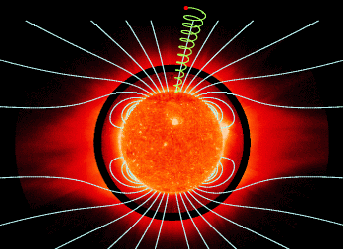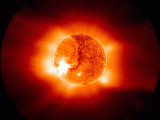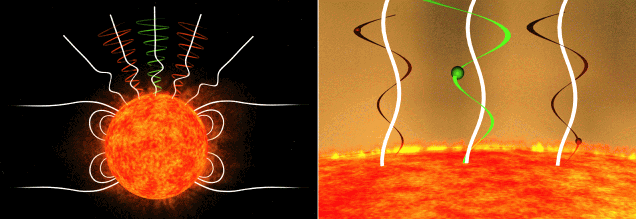
The following paper was presented at the April 2000 American Physical Society Meeting in Long Beach, California. This page is a local copy of the Lay Language Paper on the APS web site.
Steven R. Cranmer
(1-617-495-7271,
scranmer @ cfa.harvard.edu)
Harvard-Smithsonian Center for Astrophysics
Cambridge, Massachusetts
Popular Version of Paper
H14.002
Sunday morning, 30 April 2000
APS April 2000 Meeting, Long Beach, CA

(This paper is mainly a review of results presented over the last several years. There is some new material here, but the overall purpose of this paper is to convey some of the current excitement about the ongoing progress in this field of physics.)
Ultraviolet observations of the outermost parts of the Sun's atmosphere are helping scientists solve a 40-year old mystery. The Sun emits a continuous solar wind of outflowing electrically charged atoms, but the speeds of these particles are at least twice as fast as predicted by theory. An instrument aboard the SOHO spacecraft has observed the ultraviolet light emitted by atoms in the accelerating part of the solar wind, which has allowed scientists to conclude that at least some fraction of the wind is energized by vibrating magnetic waves. Future observations can determine if the entire wind is accelerated by these waves and help provide long-term predictive capabilities to our understanding of space weather.
The Mystery Begins
The solar wind was first detected in 1962 by the Mariner 2 spacecraft. However, the mysteries concerning this plasma that fills the solar system go back even further. In the late 1930s, the outermost part of the solar atmosphere, or the solar corona, was discovered to have a temperature exceeding 1 million degrees C. This was unexpected, because the solar surface has a temperature of only about 6000 degrees C. As a rule, temperatures are expected to decrease the further one gets from the source of energy (which for the Sun, ultimately, is the thermonuclear furnace at the solar core)! The cause for the rapid ``coronal heating'' above the solar surface remains somewhat of a mystery, although our observations are helping to provide an explanation.
In 1958, Eugene Parker of the University of Chicago theorized that particles in a million-degree corona should contain enough energy to naturally want to expand away from the Sun at speeds exceeding 500,000 miles per hour. This idea remained controversial until Mariner 2 detected these flowing particles, which Parker named the solar wind. However, only about half of the wind that sweeps past Earth flows at the comparatively ``slow'' speeds of 500,000 to 700,000 miles per hour. There is also a ``fast'' component that flows between 1 and 1.6 million miles per hour, that Parker's original theory could not explain.
Now, almost a half-century after its initial discovery, spacecraft have probed the solar wind both inwards from Earth (Helios flew in past the orbit of Mercury) and outwards (the intrepid Voyager probes are still going strong out past Neptune). Despite this progress, we have not been able to capture particles from the region of the wind where they accelerate from rest on the solar surface to their final coasting speeds. To understand the physics and origin of the solar wind, this region - which is expected to span only 2 to 5 solar diameters away from the Sun - is crucial. For comparison, the closest approach of the Helios spacecraft was a distance of about 30 solar diameters, and the Earth orbits at about 107 solar diameters from the Sun.

Where the Action Is
Solar physicists have been able to view the base of the solar corona for several decades by looking at ultraviolet and X-ray radiation emitted by the million-degree gas above the Sun's surface. However, down at the base, the solar wind is only barely getting started. Scientists need to view the gas up to several solar diameters away from the Sun's surface in order to observe the acceleration of the charged atoms in the solar wind. These regions are hundreds to thousands of times dimmer than the Sun itself, so until the 20th century, total solar eclipses were the only means of getting a look at the outer parts of the corona.
In the 1930s, Bernard Lyot of France invented the coronagraph, a telescope that creates an artificial eclipse by blocking out the disk of the Sun. In the 1970s, John Kohl and colleagues at the Smithsonian Astrophysical Observatory developed coronagraphs that can view solar ultraviolet light, and that can spread out this light into a spectrum (the same way a rainbow or a prism spreads out visible sunlight into its component colors). Because this light is emitted by atoms in the corona that are in motion, its spectrum is altered by the Doppler effect, which is the same phenomenon that changes the frequency, or pitch, of sound from a moving object like a train whistle depending on whether it is approaching or receding. By probing the frequencies of ultraviolet light emitted by the outer corona, it is possible to gather precise information about the motions - and thus speeds and temperatures - of different types of atoms in the solar wind.
Ultraviolet telescopes and coronagraphs are on board the Solar and Heliospheric Observatory (SOHO) spacecraft, a joint mission between NASA and the European Space Agency. The following movie shows composite images of the solar corona from the EIT (Extreme-ultraviolet Imaging Telescope) and UVCS (Ultraviolet Coronagraph Spectrometer) instruments. The Sun rotates once about every 27 days, and features on the surface can be seen to extend far into the outer corona.

In 1996, the UVCS instrument made the surprising discovery that ionized oxygen atoms are much hotter than hydrogen (which makes up the bulk of the coronal gas). Oxygen temperatures at a distance of about 1 to 2 solar diameters from the surface reach 200 million degrees C, which is about a hundred times greater than the hydrogen temperature. It was also determined that oxygen flows out faster than hydrogen, and already reaches speeds of at least 1 million miles per hour in the corona.
Surfing, Damping, and Churning
The UVCS observations of hot and fast oxygen in the extended corona have helped theorists narrow down the previously long list of potential explanations for how these particles are heated and accelerated. The most natural remaining idea is that the atoms absorb energy from high-frequency magnetic waves that propagate away from the Sun. These waves take the form of the wiggles, or back-and-forth oscillations, in the magnetic field lines that emerge from the Sun. The maximum transfer of energy from the waves to the particles occurs when there is a resonance, or a matching of frequencies between the wave oscillations and the particles' spiraling motions around the field lines. The particles are accelerated so as to eventually ``surf'' at the waves' propagation speed.

There is still much that isn't known about magnetic waves in the solar corona...
Understanding how particles in the solar wind are heated and accelerated is a necessary precursor to being able to predict the Sun's long-term effects on the Earth's local space environment. When the solar wind impacts the Earth's magnetosphere, it can interrupt communications, threaten satellites and the safety of orbiting astronauts, and disrupt ground-based power grids. Variations in the high-speed component of the solar wind (the component thought to be energized by magnetic waves) have also been shown to have an effect on the Earth's climate.
Click here for the home page of the UVCS instrument
Click here for the home page of the SOHO spacecraft (lots of public outreach and education links)
Click here for a primer on our local space environment
Click here for a news item concerning climatic changes from the fast solar wind